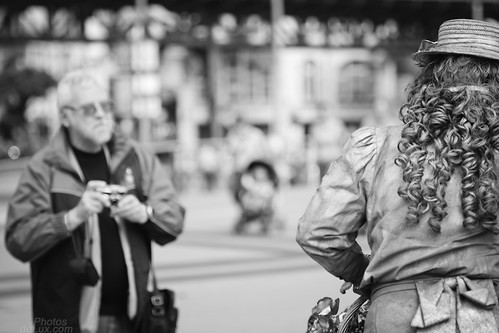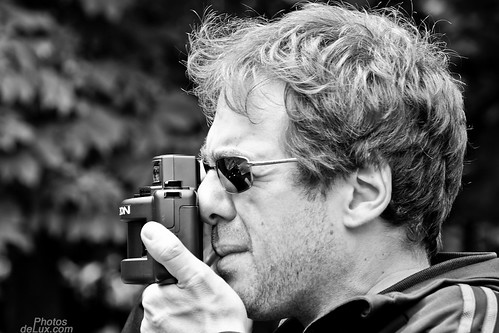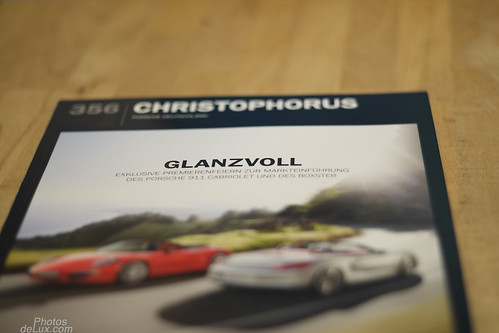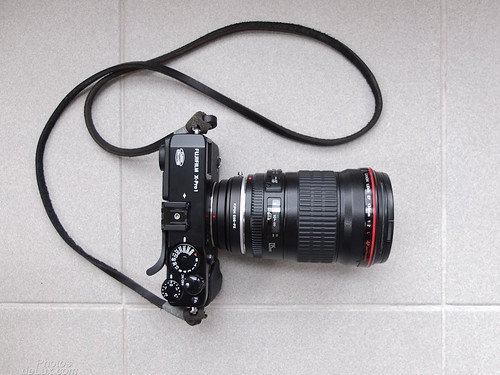After my
review on the Kipon Canon EOS to Fuji XF adapter
, I am going to write about how the Kipon Olympus OM-XF adapter performs on the Fuji X-Pro 1.
Fuji offers their own intelligent adapter for Leica M lenses. And if I were fortunate enough to own Leica M glass, I would buy the Fuji adapter in a heartbeat.
But I still own some Olympus OM Zuiko lenses from my old analog OM-4 Ti. Therefore another Kipon adapter was ordered and I had it connected to the X-Pro 1 quite often in the past month.
Unfortunately, my OM lens collection on the wide side overlaps with my current Fujinon XF lenses in terms of effective focal length. This leaves me with the Olympus OM Zuiko 50mm f/1.8 Auto-S and OM Zuiko 100mm f/2.8 Auto-T as useful additions to my current X-Pro 1 lens lineup. Great thing about those two lenses is that they are rather compact (compaed to the Olympus 50mm f/1.4 and 100mm f/2). And with the additional lengt of the Kipon OM-XF adapter, you'll want as short of a lens as you can get - unless you want to end up with an odd looking drainpipe sticking out from your slim X-Pro 1 body ;)
The biggest advantage of the OM lenses vs. the Canon EOS EF lenses is that you can select the aperture right on the lens itself. No aperture "hack" required :)
And how do they perform? The image quality is great! I mainly use the 100mm as this effective field of view equals 150mm on a full frame body. Somehow I did not find much use for the 50mm (75mm equivalent FOV), yet.
Both performe really well wide open. But in order to use them wide open your focus has to be spot on. And that is quite difficult to manage with the current stage of the EVF refresh and magnification rate offered by the X-Pro 1. Did I mention before that I wish for a second MF magnification level of 5X in addition to the 10X we already got? And focus peaking would make focusing long MF lenses so much easier...
But the way it is right now (X-Pro 1 with FW 1.10) I usually stop down on moving subjects to f/5.6 in order to get enough depth of field to compensate for focus inaccuracy. It works but it takes a bit potential away from this great combo.
So if you want to use your OM (or any other manual focus) lens wide open on the X-Pro 1 make sure you aim at static objects - possibly even with the camera set on a tripod.
Here are some sample images - as always click on the image to see a larger version:

"Last one standing" - X-Pro 1 with Olympus OM 100mm f/2.8 Zuiko at f/8

As they were posing for their own photo I was able to nail focus with the OM 100mm wide open at f/2.8 - nice bokeh, too

Architecture works also well with the OM 100mm at f/5.6 as there is virtually no distortion!

Another lucky shot with the 100mm at f/2.8 - I wished focusing this long lens would be more reliable with the EVF in scenes with moving subjects

This was shot in a crowded place but I was able to single out this undercover lady with the 100mm lens at f/5.6

This is an example of how well the OM 50mm f/1.8 looks on the X-Pro 1

And just in case if you are interested in how the OM 100mm handles color images... Looks very natural to me :)

The OM 100mm f/2.8 isn't a dedicated macro lens - but look at the details on the focus point on the "C" from Cycle in the full size image at f/2.8!!! (click the image)

And now you probably want to see how the adapter and lens combo looks like when attached to the X-Pro 1. Notice that the Kipon OM-XF adapter itself is about half as long as the 100mm lens.
To sum it up:
The Olympus OM lenses were good lenses back in the analog days. And the once I tested perform really well on the X-Pro 1, too. So if you still have some OM lenses in the drawer, think about getting an OM-XF adapter for your X-Pro 1. And if you don't have any old lenses, check for used OM lenses on the web or at you used camera store.
Against my usual believe to go for the "faster, bigger and more expensive lenses" I would suggest to go for the smaller, lighter, cheaper ones when it comes to OM 50mm f/1.4 vs. f/1.8 and OM 100mm f/2 vs. f/2.8. The "slower" lenses perform really good and due to the challenging EVF focusing on the X-Pro 1 you might end up stopping the lenses down anyway.
If you have any further questions leave a comment below or Twitter me @HamburgCam
And if you liked my post I am always happy if you spread the word and retweet, like or google +1 it :-)




